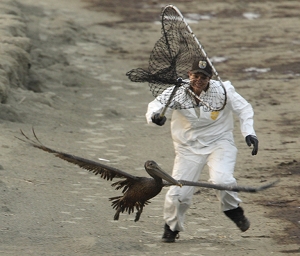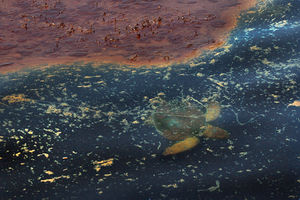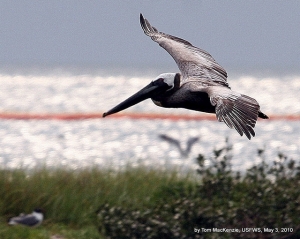NRDA preassessment work plans
NRDA Background Information
The Oil Pollution Act authorizes certain federal agencies, states and Indian tribes, collectively known as the Natural Resource Trustees (Trustees) to evaluate the impacts of the Deepwater Horizon oil spill on natural resources. The Trustees are responsible for studying the effects of the spill through a process known as Natural Resource Damage Assessment (NRDA). As part of this process, scientists from each Trustee entity work together to identify potential injuries to natural resources resulting from the spill and to design studies that will be used to determine and measure spill-related injuries (or impacts) to natural resources and their human uses. For the Deepwater Horizon spill, NRDA activities to date have been divided into categories that focus on specific organisms, habitats or uses. These categories include, for example:
- Birds
- Marine mammals (Deepwater Horizon Oil Spill and Marine Mammals) and sea turtles
- Fish and shellfish
- Deep water habitat
- Intertidal and near shore subtidal habitats (including sea grasses, mud flats, coral reefs)
- Shoreline habitats (including salt marsh, beaches, mangroves (Mangrove ecology))
- Terrestrial animals
- Human uses of natural resources (e.g., recreational fishing, boating, shoreline recreation, subsistence, cultural uses, etc.)
The first step in the NRDA process is known as the Preassessment Phase. During this phase, the Trustees collect ephemeral data for the purpose of determining, among other things, whether injuries are occurring or are likely to occur, what resources may be injured, and whether it is appropriate to conduct a full injury assessment. This phase involves collecting information about how natural resources are exposed to the oil, what is likely to occur as a result of exposure, and over what period of time impacts are expected to occur. This phase may also include studies to document the condition of resources prior to exposure to the oil and to confirm the presence of oil from the Deepwater Horizon incident. The next step in the process, which is based on the Trustees' decision to conduct a full NRDA, is the Injury Assessment Phase. During this phase, the Trustees will implement studies to evaluate the extent, severity, and duration of impacts from the oil spill. Some of these studies may need to go on for several years to fully assess the impacts to natural resources and determine the time needed for these resources to recover. Throughout the Preassessment and Injury Assessment, the Trustees will also consider how natural resources harmed by the spill may be restored through Restoration Planning, the final phase of the NRDA process. This phase will identify restoration actions which the Responsible Parties ("RPs"), including BP, will be required to pay for in order to fully compensate the public for the injuries to natural resources caused by the Deepwater Horizon oil spill. This may be accomplished through the implementation by the RP of specific restoration projects or by the payment of money damages to the Trustees. The projects, whether performed by the RP or the Trustees may include direct restoration or rehabilitation of the injured resources, or replacement or acquisition of resources equivalent to those injured.
The Trustees have and will continue to release study plans developed over the course of the spill. The process for development of each plan reflects input and advice from experienced Trustee scientists and resource managers as well as leading experts from outside the Trustee entities, including scientists who specialize in studying oil spills and natural resources in the Gulf of Mexico. The earliest approved plans are very brief as they were developed quickly to capture immediate, potentially perishable data during an evolving event. The plans also reflect the different nature of resources, data requirements, and associated study methods and techniques. Because study methods used for preassessment activities may also be applied in future injury assessment studies, some of the plans provide for both near term and longer term data collection or studies. As data from the studies become available, the Trustees may adapt study approaches or methods, or consider conducting additional studies, as needed, to ensure that the impacts of the oil spill can be fully identified and measured. This iterative process is intended to obtain the highest quality scientific information available to determine how much harm to resources has occurred and how much restoration is required.

As permitted under the Oil Pollution Act's NRDA regulations, in some instances BP has been working cooperatively with the Trustees to collect preassessment data and to conduct NRDA activities. The Trustees have afforded BP the opportunity to provide input to the Trustees in the development of preassessment study plans and many of the plans have been signed off on by representatives of Trustees and BP. Cooperation facilitates the collection and sharing of reliable data, while allowing all parties to conduct their own analysis and interpretation of that data. Trustees for the Deepwater Horizon oil spill include agencies or officials of the following:
- State of Louisiana
- State of Mississippi
- State of Alabama
- State of Florida
- State of Texas
- U.S. Department of the Interior, through the U.S. Fish and Wildlife Service, National Parks Service, Bureau of Land Management, and Bureau of Indian Affairs
- U.S. Department of Commerce, through the National Oceanic and Atmospheric Administration
For more information about the NRDA process for the Deepwater Horizon Oil Spill, please visit the U.S. Fish and Wildlife Service Environmental Contaminants Homepage, the National Park Service website, or the National Ocean and Atmospheric Administration Damage Assessment, Remediation & Restoration Program website.
Work Plans
- Determining Injury to the Piping Plover - August 4, 2010 - {Download
 }* Texas Baseline Survey and Sampling - August 2, 2010 - {Download
}* Texas Baseline Survey and Sampling - August 2, 2010 - {Download  }
} - Pre-Impact Sampling Plan for West Coast of Florida - July 23, 2010 - {Download
 }
} - Shorline/Vegetation Pre-assessment Data Collection Plan - July 12, 2010 - {Download
 }
} - Estimating Oiling and Mortality of Breeding Colonial Waterbirds - July 10, 2010 - {Download
 }
} - NRDA Tier 1 for Deepwater Communities: Work Plan and SOPs - June 27, 2010 - {Download
 }
} - Estimating Oiling Rates Among Pelagic Birds Using Ship Based Surveys - June 24, 2010 - {Download
 }
} - Water Column Injury Ephemeral Data Collections: NRDA Cruise 4 - June 11, 2010 - {Download
 }
} - Collection of Data to Determine Impacts on Endangered and Protected Marine Mammals in the Northern Gulf - June 11, 2010 - {Download
 }
} - Proposed Data Collection Plan to Assess Injury to Florida Manatees - June 9, 2010 - {Download
 }
} - Assess Injury to West Indian Manatees Outside of Florida - June 9, 2010 - {Download
 }
} - Aerial Surveys and Photographic Census for Birds - June 7, 2010 - {Download
 }
} - Nearshore Water Column Injury Ephemeral Data Collections: Submerged Oil Reconnaissance Plan - June 5, 2010 - {Download
 }
} - Baseline Sediment and Water Collection and Analyses in Florida Keys - June 4, 2010 - {Download
 }
} - Surface Water Sampling Plan for Dispersant Treated Oil - May 29, 2010 - {Download
 }
} - ADCP-Measured Currents Monitoring Plan - May 26, 2010 - {Download
 }
} - Samples of Opportunity in Support of the Water Column Baseline - May 24, 2010 - {Download
 }
} - Estimating Mortality of Birds Using Beached Bird Surveys in Louisiana - May 22, 2010 - {Download
 }
} - Data collection for NOAA Vessel Gordon Gunter - May 21, 2010 - {Download
 }
} - Surface Water Sampling Plan - May 21, 2010 - {Download
 }
} - Surface Water Sampling Plan (Amended) - May 21, 2010 - {Download
 }
} - Aerial Surveys for Assessing Marine Mammals and Sea Turtles - May 15, 2010 - {Download
 }
} - Samples of Opportunity in Support of the Water Column Injury - May 13, 2010 - {Download
 }
} - Water-Column Profiling to Measure Dissolved Aromatic Hydrocarbons and Free Oil Droplets - Proposal to Extend - May 10, 2010 - {Download
 }
} - Water-Column Profiling to Measure Dissolved-Phase Aromatic Hydrocarbons and Free Oil Droplets - May 7, 2010 - {Download
 }
} - Cooperative Research Cruise to Document Biotic Effects - May 4, 2010 - {Download
 }
}


